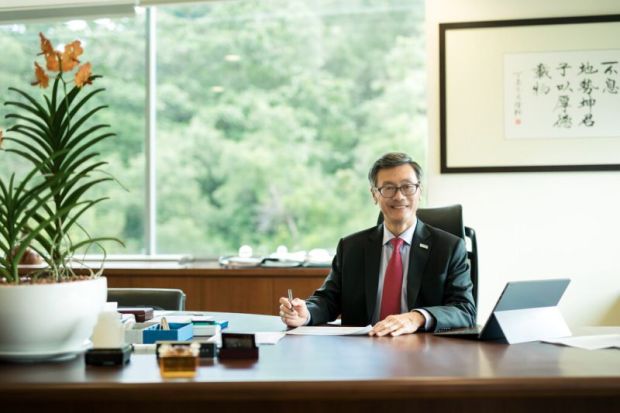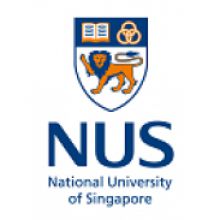Tan Eng Chye’s daughter is an opera singer and also works for an electronics company. She is the living embodiment of his idea that people should have two skill sets in case the job market changes rapidly and one becomes obsolete.
The president of the National University of Singapore (NUS) has a laser-like focus on his students’ employability. He gives the impression that, if he could, he would be the personal recruitment adviser to each of them and that if any were to find themselves unemployed, he would hold himself personally culpable.
Fear of automation and the relentless transformation of the labour market has led to many a conversation on lifelong learning in the offices of university administrators and policymakers, but no institution has embraced the idea quite like NUS.
In the latest in our Talking Leadership series, Times Higher Education speaks to Tan about the progress NUS has made since March 2018, when it began the process of “reimagining the function of a university” towards supporting learning for life.
‘A huge problem’
Tan has in mind a hypothetical mechanical engineer: a man or woman who graduates at 22 years old, works in production for 20 years but fails to pick up any new skills, and finds themselves redundant at 42 because their firm can automate much of their work.
“I have another good 20 to 25 years to go in my career,” he says, putting himself in their place. “And suddenly, I’ve realised that my skill sets are obsolete because I've not been upgrading myself over the past 20 years. That’s a huge problem.”
To prevent his disaster scenario, Tan, who was the first in his family to receive a degree, has embarked on a total overhaul of how NUS functions. He has changed undergraduate degrees from focusing on “depth” of knowledge to “breadth” to give students a broad base for lifelong learning, granted all NUS students 20 years of free continuing education, and is working closely with industry insiders to ensure that NUS courses provide students with up-to-date skills.
From depth to breadth
In their four-year undergraduate courses, NUS students now follow a broad general curriculum for a year and a half, specialise for the next 18 months, then either continue with their chosen area or pick up another specialism for their final year.
Tan likens the approach to the symbol for pi (Π), with the horizontal line representing broad-based general learning and the two vertical lines each representing a specialisation, such as his daughter’s opera and creative design skill sets.
“Our graduates need to have options,” he says. “Our challenge is this: if you are focused on one, what if this particular branch of knowledge becomes obsolete?”
The curriculum also involves a heavy dose of interdisciplinary teaching, something Tan is almost as passionate about as employment, because “problems don’t fit nicely within one discipline”.
After graduating, NUS alumni can return and sign up for any of a vast array of microcredentials and short courses. From “artificial intelligence for non-AI scientists” to “accounting information systems”, graduates can study and explore any subject no matter the topic of their undergraduate degree, because, Tan believes, their general undergraduate course has set them up for lifelong learning: “If you graduated from NUS, you're good enough.”
This has, of course, required many changes to the functioning of the university, not least to teaching. Because older learners must fit education around a career, classes use a blended approach and provide much of the content via online footage, with fortnightly in-person discussions on campus.
As a result, academics have had to convert their lectures into bite-sized videos, which some have taken to more than others, Tan says. NUS has developed a technical team to support lecturers to do this, and it provides a training course to upskill academics.

Adaptive learning
Accepting all graduates on any course presents another challenge: some students will have more relevant experience and therefore be more capable than others. To address this, NUS is experimenting with “adaptive learning,” in which the academic sets a taxonomy of knowledge and skills and students work their way through each point.
“If I've understood point one, then I'll move to point two, then I'll move to point three, and so on and so forth,” Tan explains.
“Once you have a taxonomy of skills and knowledge, you can actually use technology to channel the students according to their learning capabilities. Think of a gamification framework, map on to this a taxonomy of skill sets and competencies. Then we have adaptive learning.”
Setting the taxonomy is not straightforward, Tan admits. “Teachers are smart, but sometimes they don’t scrutinise how people learn…the teacher needs to be able to understand that different people with different capabilities have different trajectories in terms of thinking.”
Some academics might balk at the extra teaching work required, but a system that NUS had in place before its shift to lifelong learning mitigates this to some extent.
As well as the traditional “tenure track”, NUS has an “educator track”, which allows those academics more interested in teaching to focus on their passion.
“There’s always the feeling [that] the educator track is second class,” Tan concedes, but the institution tries to temper this by ensuring that educator track academics are paid the same as those on the traditional research tenure track.
A third “practice track” provides a career trajectory for academics who still have a foot in industry. Tan says having scholars on this path is especially useful for students of subjects such as business, law, engineering, psychology, social work and data science because they “need the practitioners to bring in the real-life problems to our classroom”.
These practice track professors help the university stay on the pulse when it comes to the knowledge and skills it needs to teach its students to keep up with the jobs market. In this endeavour, NUS has also established industry advisory panels for each course, and the institution’s emphasis on internships sees students move between the workplace and university, spreading knowledge as they go.
Technology, unsurprisingly, is central to the university’s upskilling agenda. An AI-driven app called Career Plus built by NUS computer scientists pulls data on required skills from jobs websites, cross-references it with skills a student already possesses, and suggests the courses they need to take to fill any gaps.
Changing minds
Such sweeping changes are not straightforward, so what has been the hardest part? “Mindset,” says Tan, of academics and students alike. He had to convince both groups that education post-graduation is as important as education pre-graduation.
“Students still come with a certain mindset: four-year university education [and] they are made for life [they believe], particularly young graduates,” he says. “They still don’t have that mindset that I need to learn continually over time to build my own capability for my own professional development.”
This work is not cheap. NUS is in the fortunate position of having a government committed to lifelong learning: the Singaporean government’s Skills Future scheme pays up to 90 per cent of each student’s tuition fees for an upskilling course. Master’s students pay for themselves, providing an income stream for the university.
NUS currently has about 1,600 master’s students and some 1,000 graduates taking shorter courses. Thousands more non-NUS older learners also take the institution’s short courses. Ideally though, Tan would have 7,000 to 8,000 NUS alumni taking a course each year, with everyone coming back every five years at least.
Some might assume the upskilling agenda is focused purely on technology and STEM subjects, but NUS also caters to the arts, offering a master’s in arts and cultural entrepreneurship and another in music leadership, for example.
“This is more to really address people with very specific skills,” Tan says. “You don’t build something that is diametrically opposite. I can’t ask a musician to learn computer science tomorrow. There will be a big difference in terms of the ability, what they are trained for, and what they can do. So, we need to look for adjacent types of competencies.”
Not born to lead
When it comes to leadership, Tan appears to be reluctant.
“I don’t think I was born a leader,” he says. “Neither do I want to be a leader. At some stage in my life, I was just asked…would you like to do this? Can you help? And I went into it.”
He believes that leading a university requires a calm temperament – “talented people can also be stubborn and very eccentric” – as well as the ability to excite people and convince them to work in certain directions.
Despite his reticence, he appears to relish higher education and his role within it, particularly bringing people together across disciplines.
“One of the great enjoyments is to talk to my colleagues and have them to teach me and make me understand the things they’re doing…and one of my joys is how to connect them,” he says. “I become a matchmaker of greater ideas.”
In terms of recalibrating NUS towards lifelong learning, if he were embarking on the project from scratch is there anything he would do differently?
“I wish that I could push it faster,” he says. “I feel that the disruptions to society will be much greater in the next few years. Our graduates will have even more challenging times. I really wish that I had done a lot of this earlier, to better prepare them.”
Quick facts
Born: Singapore, 1961
Academic qualifications: BSc in mathematics from NUS; PhD from Yale University
Lives with: His wife and one child; three others have left home
Academic hero: Roger Howe, professor emeritus of mathematics at Yale and Tan’s PhD supervisor
This is part of our “Talking leadership” series of 50 interviews over 50 weeks with the people running the world’s top universities about how they solve common strategic issues and implement change. Follow the series here.
Register to continue
Why register?
- Registration is free and only takes a moment
- Once registered, you can read 3 articles a month
- Sign up for our newsletter
Subscribe
Or subscribe for unlimited access to:
- Unlimited access to news, views, insights & reviews
- Digital editions
- Digital access to THE’s university and college rankings analysis
Already registered or a current subscriber? Login










